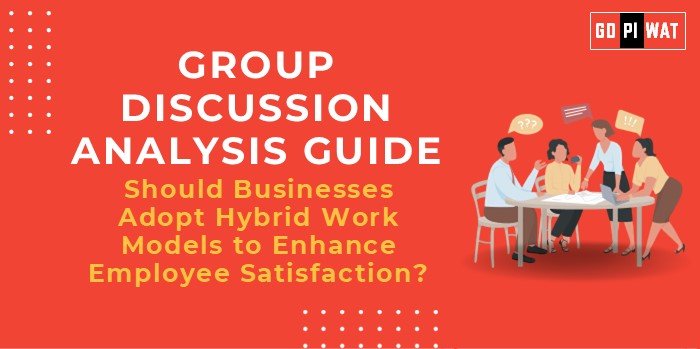📋 Group Discussion Analysis Guide
🌐 Topic: Should Businesses Adopt Hybrid Work Models to Enhance Employee Satisfaction?
🌟 Introduction to the Topic
Hybrid work models combine in-office and remote work, becoming a defining trend post-pandemic. Companies globally, from tech giants like Google to financial firms like JP Morgan, are debating the model’s long-term implications for employee satisfaction, productivity, and organizational culture.
📊 Quick Facts and Key Statistics
- 💼 Employee Preference: 73% of employees favor flexible work arrangements (PwC, 2024).
- 📈 Productivity Boost: Remote-capable jobs report a 9% productivity increase (Gartner, 2023).
- 📉 Attrition Rates: Companies offering hybrid models experience 20% lower attrition (McKinsey, 2024).
- 💰 Real Estate Savings: Businesses save up to 30% on operational costs with reduced office space (CBRE, 2024).
👥 Stakeholders and Their Roles
- 💼 Employers: Need to balance operational efficiency with workforce well-being.
- 🧑💻 Employees: Desire flexibility for better work-life integration.
- 📡 Technology Providers: Enable seamless collaboration through digital tools.
- ⚖️ Governments: May introduce labor regulations impacting remote work.
✔️ Achievements and Challenges
🎯 Achievements
- 😃 Enhanced Employee Satisfaction: Hybrid models cater to diverse preferences.
- 🌍 Increased Talent Pool: Access to global talent, irrespective of location.
- 💸 Cost Efficiency: Lower overhead costs for businesses.
- 🌱 Sustainability Impact: Reduced commuting decreases carbon footprint.
⚠️ Challenges
- 🤝 Collaboration Gaps: Remote work may hinder teamwork and innovation.
- ⚖️ Inequality Concerns: Not all roles can be remote, creating disparities.
- 🔍 Employee Monitoring: Over-surveillance risks trust and morale.
- 🧠 Mental Health: Isolation can negatively impact well-being.
🌍 Global Comparisons
- 🏆 Successful Example: Microsoft’s hybrid strategy has increased employee engagement scores by 15%.
- ❌ Challenges: In Japan, cultural norms favor in-office presence, slowing hybrid adoption.
📖 Case Study
Tata Consultancy Services (TCS): TCS adopted a “25/25 model,” with 25% of the workforce in-office at any time. The company reports sustained productivity and satisfaction.
📑 Structured Arguments for Discussion
- ✅ Supporting Stance: “Hybrid models empower employees, enhance satisfaction, and reduce attrition.”
- ❌ Opposing Stance: “Hybrid models compromise team synergy and blur work-life boundaries.”
- ⚖️ Balanced Perspective: “While hybrid models promote flexibility, they require careful policy design to ensure fairness and productivity.”
💡 Effective Discussion Approaches
🔑 Opening Approaches
- 📊 Statistical Opening: “73% of employees prefer hybrid models, showing a shift in workplace priorities.”
- 📖 Case Study: “TCS’s hybrid model highlights productivity gains without compromising employee satisfaction.”
🔄 Counter-Argument Handling
- For synergy concerns: Emphasize tools like Slack and MS Teams that enhance remote collaboration.
- For inequality: Advocate for clear policies ensuring equitable treatment.
🛠 Strategic Analysis of Strengths and Weaknesses
- ✔️ Strengths: Flexibility, cost savings, global talent access.
- ❌ Weaknesses: Collaboration barriers, potential inequality.
- 🚀 Opportunities: Adopting advanced tools for seamless communication.
- ⚠️ Threats: Cultural resistance and legal challenges.
📚 Connecting with B-School Applications
- 📂 Real-World Applications: Case studies in HR policies, organizational behavior projects.
- 📝 Sample Interview Questions:
- “What challenges do hybrid models pose for organizational culture?”
- “How can technology mitigate collaboration issues in hybrid setups?”
- 🎓 Insights for B-School Students: Understanding the implications of hybrid work on global talent management and operational efficiency.


